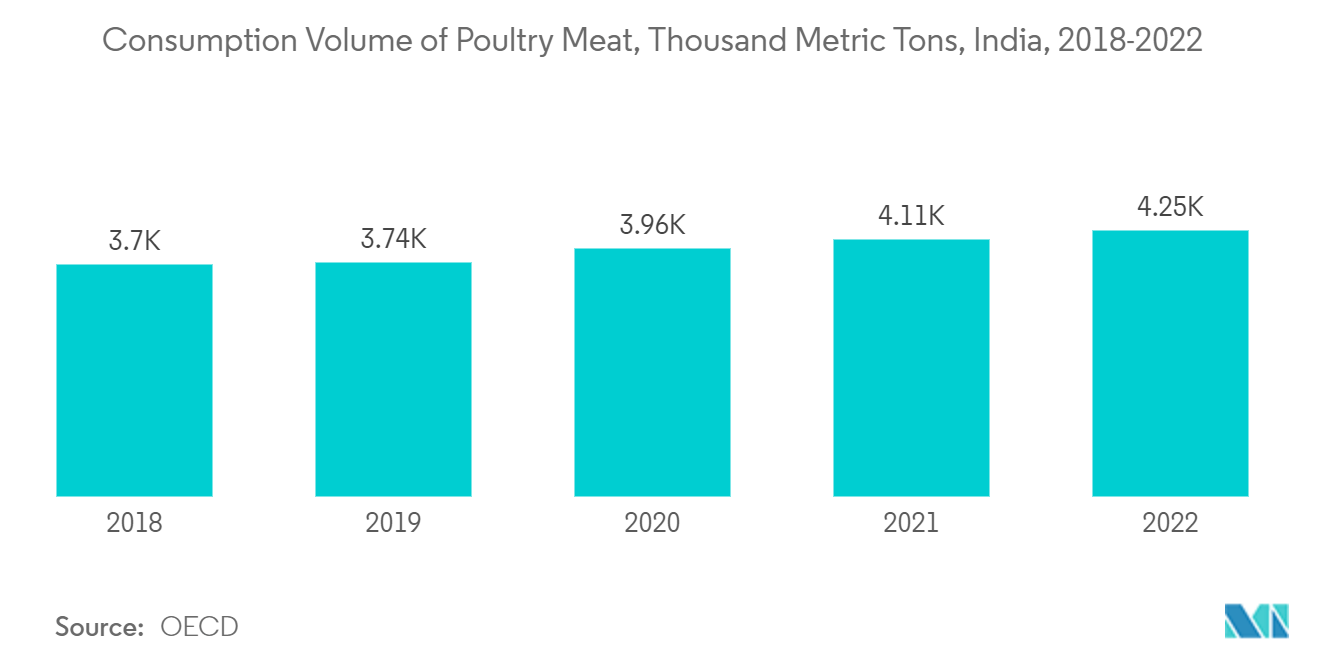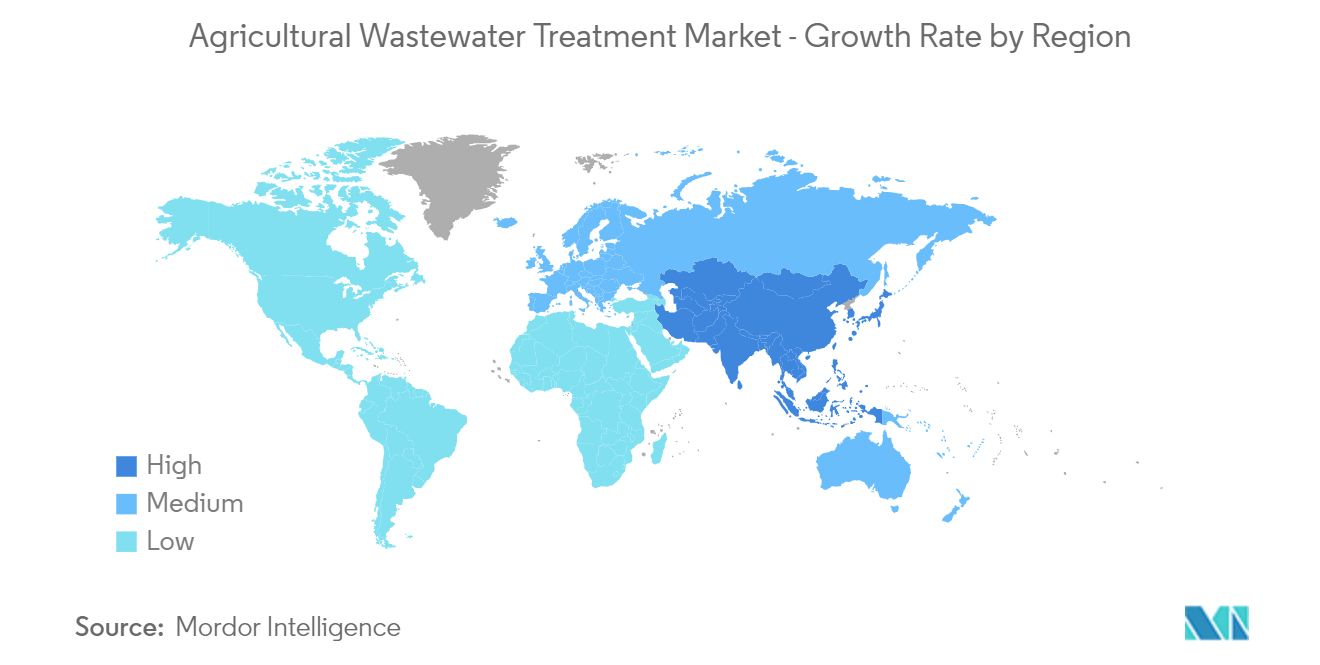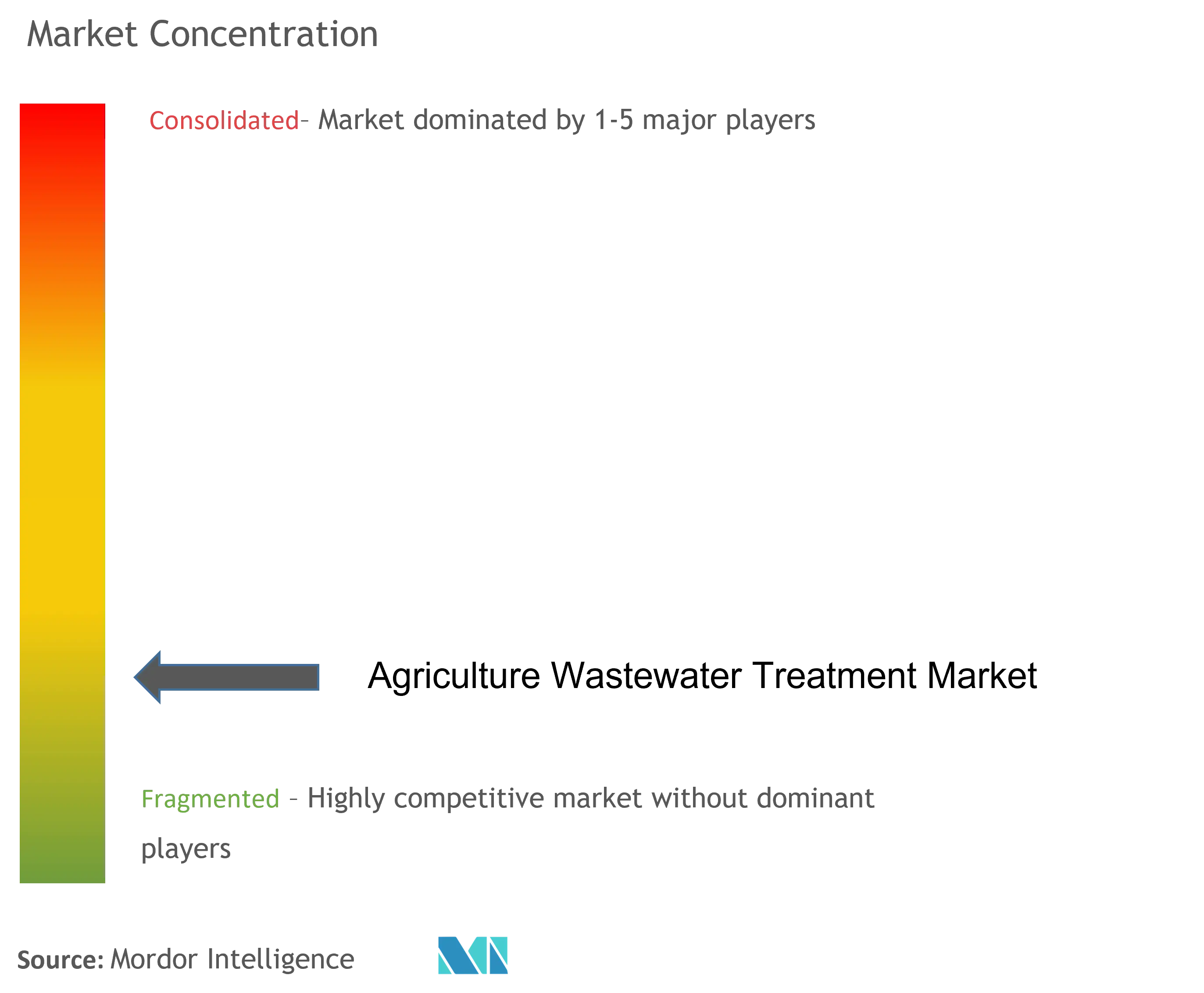Agricultural Wastewater Treatment Market Size

| Study Period | 2019 - 2029 |
| Market Size (2024) | USD 2.39 Billion |
| Market Size (2029) | USD 3.02 Billion |
| CAGR (2024 - 2029) | 4.75 % |
| Fastest Growing Market | Asia Pacific |
| Largest Market | Asia Pacific |
| Market Concentration | Medium |
Major Players
*Disclaimer: Major Players sorted in no particular order |
Agricultural Wastewater Treatment Market Analysis
The Agricultural Wastewater Treatment Market size is estimated at USD 2.39 billion in 2024, and is expected to reach USD 3.02 billion by 2029, growing at a CAGR of 4.75% during the forecast period (2024-2029).
The COVID-19 outbreak brought several short-term and long-term consequences in various industries, such as agriculture, and water treatment affecting the market. The agriculture industry was widely impacted due to supply chain disruption and a halt in the production of chemical manufacturing companies. It is due to lockdown and workforce shortages, thus, adversely affecting the market. For instance, worldwide, the lockdowns in Europe greatly disrupted food supply chains. According to Syngenta, about 46% of large European farming businesses were impacted by the COVID-19 pandemic.
- Rapidly diminishing freshwater resources and rising agricultural water demand are likely to drive the demand for the studied market.
- On the flip side, a dearth of awareness regarding agriculture wastewater treatment is expected to hinder the market growth.
- Growing investments and active research on water treatment technologies are expected to provide a major growth opportunity for the market studied.
Agricultural Wastewater Treatment Market Trends
Non-Crop Segment to Dominate the Market
- Non-crop is the largest application for agricultural wastewater treatment across the world and is increasing at a steady rate. This segment primarily includes feed production and also dairy farms, and poultry. Despite low calorie and protein supply as compared to plant-based food, livestock, meat, and dairy still hold the largest share in terms of consumption.
- Asia-Pacific is the second-most active region for processed food globally in terms of poultry. New product development (NPD) accounts for 24% of processed meat, poultry, and fish product innovations in the region, led by China, Thailand, South Korea, Vietnam, and the Philippines.
- African swine fever (ASF) further stimulated chicken expansion in Asia. Southeast Asia's poultry production expanded by 56% in the last decade and is expected to reach 12.3 million metric tons by 2028.
- According to Statistics Canada, the total sales of poultry in Canada increased by 14.0% from the previous year to USD 4.2 billion in 2022. In Canada, chicken production accounted for 90.1% of the total poultry production.
- All the above-mentioned factors are driving the non-crop application segment during the forecast period.

China to Dominate the Asia-Pacific Market
- China accounts for approximately 7% of the overall agricultural acreage globally, thus feeding 22% of the world population. The country is the largest producer of various crops, including rice, cotton, potatoes, and other vegetables. Hence, the demand for agricultural wastewater treatment is rapidly increasing in the country.
- The population of China has grown at a staggering rate in the past decade, and more than half of the population now lives in cities. With the government promoting economic growth, urbanization is on the rise. This is expected to increase the demand for improvement in agricultural wastewater infrastructure.
- According to the Chinese National Bureau of Statistics (CNBS), China's summer crop sown area increased by 0.3% year on year, reaching 26.53 million hectares. This represents an increase of 92,100 hectares compared to the previous year.
- The United States Department of Agriculture (USDA) projects that the demand for poultry products, particularly white broiler products, will reach 14.475 million metric tons in 2023.
- In March 2023, China's poultry meat exports amounted to USD 63 million, while imports reached USD 410 million, as reported by Observatory of Economic Complexity (OEC). The main destinations for poultry meat exports were Hong Kong, Macau, Bahrain, Georgia, and Mongolia.
- Based on the aforementioned aspects, China is expected to dominate the Asia-Pacific region.

Agricultural Wastewater Treatment Industry Overview
The agriculture wastewater treatment market is fragmented, with the presence of majorly multinational players. Some of the major players in the market (not in any particular order) include Veolia Environnement SA, Suez SA, Evoqua Water Technologies LLC, DuPont, and Jacobs.
Agricultural Wastewater Treatment Market Leaders
-
Suez
-
Evoqua Water Technologies LLC
-
Veolia
-
DuPont
-
Jacobs
*Disclaimer: Major Players sorted in no particular order

Agricultural Wastewater Treatment Market News
- September 2022: Lanxess commissioned a new wastewater treatment plant at its Belgium Kallo/Antwerp site. The company invested around EUR 12 million (USD 12.65 million) in the plant, having a treatment capacity of around 260,000 liters of wastewater per hour.
- June 2022: AECOM, a global engineering, consulting, and construction services company, completed the design for its new North Shore wastewater treatment plant. The North Shore wastewater treatment plant is a significant project aimed at addressing wastewater management and environmental sustainability.
Agricultural Wastewater Treatment Market Report - Table of Contents
1. INTRODUCTION
1.1 Study Assumptions
1.2 Scope of the Study
2. RESEARCH METHODOLOGY
3. EXECUTIVE SUMMARY
4. MARKET DYNAMICS
4.1 Drivers
4.1.1 Rapidly Diminishing Fresh Water Resources
4.1.2 Rising Agricultural Water Demand
4.1.3 Other Drivers
4.2 Restraints
4.2.1 Dearth of Awareness regarding Agriculture Wastewater Treatment
4.2.2 Other Restraints
4.3 Industry Value Chain Analysis
4.4 Porter's Five Forces Analysis
4.4.1 Bargaining Power of Suppliers
4.4.2 Bargaining Power of Consumers
4.4.3 Threat of New Entrants
4.4.4 Threat of Substitute Products and Services
4.4.5 Degree of Competition
5. MARKET SEGMENTATION (Market Size in Value)
5.1 Technology
5.1.1 Physical Solutions
5.1.2 Chemical Solutions
5.1.3 Biological Solutions
5.2 Pollutant Source
5.2.1 Point Source
5.2.2 Nonpoint Source
5.3 Application
5.3.1 Crop
5.3.2 Non-Crop
5.4 Geography
5.4.1 Asia-Pacific
5.4.1.1 China
5.4.1.2 India
5.4.1.3 Japan
5.4.1.4 South Korea
5.4.1.5 Rest of Asia-Pacific
5.4.2 North America
5.4.2.1 United States
5.4.2.2 Canada
5.4.2.3 Mexico
5.4.3 Europe
5.4.3.1 Germany
5.4.3.2 United Kingdom
5.4.3.3 France
5.4.3.4 Italy
5.4.3.5 Rest of Europe
5.4.4 South America
5.4.4.1 Brazil
5.4.4.2 Argentina
5.4.4.3 Rest of South America
5.4.5 Middle-East and Africa
5.4.5.1 Saudi Arabia
5.4.5.2 South Africa
5.4.5.3 Rest of Middle-East and Africa
6. COMPETITIVE LANDSCAPE
6.1 Mergers and Acquisitions, Joint Ventures, Collaborations, and Agreements
6.2 Market Share (%)**/Ranking Analysis
6.3 Strategies Adopted by Leading Players
6.4 Company Profiles
6.4.1 AECOM
6.4.2 Aquatech International LLC
6.4.3 BASF SE
6.4.4 DuPont
6.4.5 Evoqua Water Technologies LLC
6.4.6 IDE
6.4.7 Jacobs
6.4.8 Lindsay Corporation
6.4.9 Louis Berger International
6.4.10 Nouryon
6.4.11 Organo Corporation
6.4.12 OriginClear
6.4.13 SUEZ
6.4.14 Veolia
- *List Not Exhaustive
7. MARKET OPPORTUNITIES AND FUTURE TRENDS
7.1 Growing Investments and Active Research on Water Treatment Technologies
7.2 Other Opportunities
Agricultural Wastewater Treatment Industry Segmentation
Agricultural wastewater treatment is a farm management program for controlling pollution from confined animal operations and surface runoff that may be contaminated by chemicals in pesticides, fertilizer, irrigation water, animal slurry, or crop residues.
The agricultural wastewater treatment market is segmented by technology, pollutant source, application, and geography. On the basis of technology, the market is segmented by physical, chemical, and biological. By pollutant source, the market is segmented by point source and nonpoint source. On the basis of application, the market is segmented by crop and non-crop. The report also covers the market sizes and forecasts for the agricultural wastewater treatment market in 15 countries across major regions.
For each segment, the market sizing and forecasts have been done on the basis of revenue (USD).
| Technology | |
| Physical Solutions | |
| Chemical Solutions | |
| Biological Solutions |
| Pollutant Source | |
| Point Source | |
| Nonpoint Source |
| Application | |
| Crop | |
| Non-Crop |
| Geography | |||||||
| |||||||
| |||||||
| |||||||
| |||||||
|
Agricultural Wastewater Treatment Market Research FAQs
How big is the Agricultural Wastewater Treatment Market?
The Agricultural Wastewater Treatment Market size is expected to reach USD 2.39 billion in 2024 and grow at a CAGR of 4.75% to reach USD 3.02 billion by 2029.
What is the current Agricultural Wastewater Treatment Market size?
In 2024, the Agricultural Wastewater Treatment Market size is expected to reach USD 2.39 billion.
Who are the key players in Agricultural Wastewater Treatment Market?
Suez, Evoqua Water Technologies LLC, Veolia, DuPont and Jacobs are the major companies operating in the Agricultural Wastewater Treatment Market.
Which is the fastest growing region in Agricultural Wastewater Treatment Market?
Asia Pacific is estimated to grow at the highest CAGR over the forecast period (2024-2029).
Which region has the biggest share in Agricultural Wastewater Treatment Market?
In 2024, the Asia Pacific accounts for the largest market share in Agricultural Wastewater Treatment Market.
Agricultural Wastewater Treatment Industry Report
Statistics for the 2024 Agricultural Wastewater Treatment market share, size and revenue growth rate, created by ����vlog��ý™ Industry Reports. Agricultural Wastewater Treatment analysis includes a market forecast outlook to for 2024 to 2029 and historical overview. Get a sample of this industry analysis as a free report PDF download.



